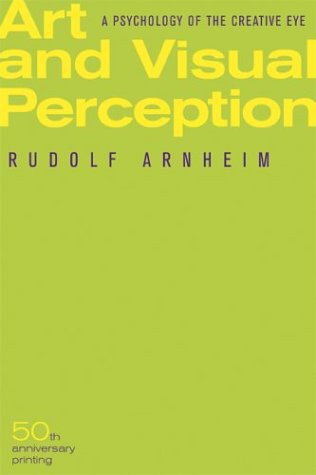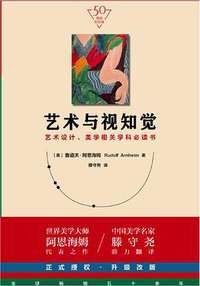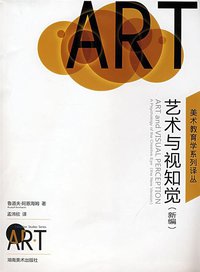Art and Visual Perception
豆瓣
A Psychology of the Creative Eye
Rudolf Arnheim
简介
Since its publication fifty years ago, this work has established itself as a classic. It casts the visual process in psychological terms and describes the creative way one's eye organizes visual material according to specific psychological premises. In 1974 this book was revised and expanded, and since then it has continued to burnish Rudolf Arnheim's reputation as a groundbreaking theoretician in the fields of art and psychology.
contents
This is the 1974 expanded and revised edition, with some new illustrations, of the original publication of 1954
Copyright 1954, 1974, by the Regents of the University of Califonia
ISBN: 0-520-24383-8
Contents
Preface to the new version
Introduction
I. Balance
The hidder structure of a square, 10
What are perceptual forces? 16
Two disks in a square, 18
Psychological and physical balance, 19
Why balance? 20
Top and bottom, 30
Right and left, 33
balance and the human mind, 36
Madame Cezanne in a yellow chair, 37
II. Shape
Vision as avtive exploration, 42
Grasping the wssentials, 43
Perceptual concepts, 44
What is shape? 47
The influence of the past, 48
Seeing shape, 51
Simplicity, 55
Simplification demonstrated, 63
Leveling and sharpening, 66
A ehole maintains itself, 67
Subdivision, 69
Why the eyes often tell the truth, 73
Subdivision in the arts, 74
What is a part? 76
Similarity and difference, 79
Examples from art, 88
The structural skeleton, 92
III. Form
Orientation in space, 98
Projections, 103
Which aspect is best? 106
The Egyptian method, 112
Foreshortening, 116
Overlapping, 120
What good does overlapping do? 123
Interplay of plane and depth, 127
Competing aspects, 130
Realism and reality, 134
What looks lifelike? 136
Form as invention 139
Levels of abstraction, 144
La source, 152
Visual information, 156
IV. Growth
Why do children draw that way? 163
The intellectualistic theory, 164
They draw what they see, 167
Representational concepts, 169
Drawing as motion, 171
The primordial circle, 174
The law of differentiation, 179
Verticle and horizontal, 182
Obliqueness, 187
The fusion of parts, 191
Size, 195
The misnamed tadpoles, 197
Translation into two dimensions, 199
Educational consequences, 203
The birth of form in sculpture, 208
Sticks and slabs, 209
The cube and the round, 215
V. Space
Line and contour, 219
Contour rivalry, 223
Figure and gound, 227
Depth levels, 233
Application to painting, 234
Frames and windows, 239
Concavity in sculpture, 241
Why do we see depth? 245
Depth by overlapping, 248
Transparency, 253
Deformations create space, 269
Simple rather than truthful, 271
Gradients create depth, 275
Toward a convergence of space, 280
The two roots of central perspective, 283
Not a faithful projection, 285
Pyramidal space, 287
The symbolism of a focused world, 294
Centrality and infinity, 297
Playing with the rules, 298
VI. Light
The experience of light, 303
Relative brightness, 305
Illumination, 309
Light creates space, 311
Shadows, 315
Painting without lighting 320
The symbolism of light, 324
VII. Color
From light to color, 330
Shape and color, 332
How colors come about, 337
The generative primaries, 339
Addition and subtraction, 341
Generative complementaries, 342
A capricious medium, 344
The quest for harmony, 346
The elements of the scale, 350
Syntax of combinations, 353
The fundamental complementaries, 357
Interaction of color, 362
matisse and El Greco, 364
Reactions to color, 368
Warm and cold, 369
VIII. Movement
Happenings and time, 372
Simultaneity and sequence, 375
When do we see motion? 378
Direction, 382
The revelations of speed, 384
Stroboscopic movement, 387
Some problems of film editing, 392
Visible motor forces, 394
A scale of complexity, 398.
The body as instrument, 403
The kinesthetic body image, 406
IX. Dynamics
Simplicity is not enough, 410
Dynamics and its traditional interpretations, 412
A diagram of forces, 416
Experiments on directed tension, 419
Immobile motion, 423
The dynamics of obliqueness, 424
Tension in deformation, 428
Dynamic composition, 432
Stroboscopic effects, 434
How does dynamics come about? 437
Examples from art, 440
X. Expression
Traditional theories, 445
Expression embedded in structure, 449
The priority of expression, 454
Symbolism in art, 457
Notes 463
Bibliography 487
Index 503



